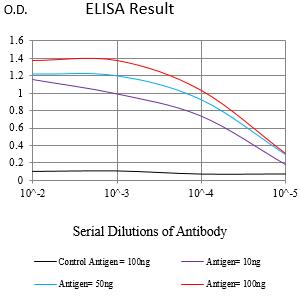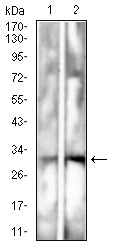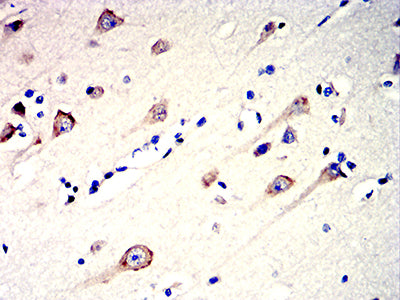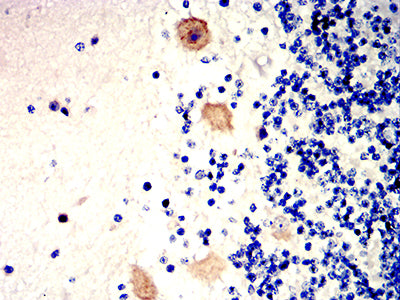




| WB | 1/500 - 1/2000 | Human,Mouse,Rat |
| IF | 咨询技术 | Human,Mouse,Rat |
| IHC | 1/200 - 1/1000 | Human,Mouse,Rat |
| ICC | 技术咨询 | Human,Mouse,Rat |
| FCM | 1/200 - 1/400 | Human,Mouse,Rat |
| Elisa | 1/10000 | Human,Mouse,Rat |
| Aliases | BST1 |
| Entrez GeneID | 683 |
| clone | 1A4G4 |
| WB Predicted band size | 35.7kDa |
| Host/Isotype | Mouse IgG2b |
| Antibody Type | Primary antibody |
| Storage | Store at 4°C short term. Aliquot and store at -20°C long term. Avoid freeze/thaw cycles. |
| Species Reactivity | Human, Mouse, Rat |
| Immunogen | Purified recombinant fragment of human CD157 (AA: 82-293) expressed in E. Coli. |
| Formulation | Purified antibody in PBS with 0.05% sodium azide |
+ +
以下是关于CD157抗体的3篇参考文献及其摘要概述:
1. **"Autoantibodies against CD157 in systemic lupus erythematosus: Clinical significance and genetic association"**
- **作者**: Hirata Y, et al.
- **摘要**: 该研究发现系统性红斑狼疮(SLE)患者血清中存在抗CD157自身抗体,并探讨了其与疾病活动性及特定基因变异(如BST1基因)的关联,提示CD157抗体可能参与SLE的免疫病理机制。
2. **"CD157 in ovarian carcinoma: A potential therapeutic target for antibody-based immunotherapy"**
- **作者**: Ortolan E, et al.
- **摘要**: 文章综述了CD157在卵巢癌细胞中的高表达及其与肿瘤转移和免疫抑制微环境的关系,提出开发靶向CD157的抗体可能增强抗肿瘤免疫反应,为临床治疗提供新策略。
3. **"Structural insights into CD157-mediated immune regulation and antibody development"**
- **作者**: Murakami Y, et al.
- **摘要**: 通过解析CD157的晶体结构,研究揭示了其与配体相互作用的关键位点,为设计阻断CD157功能的高效抗体(如抗炎或抗肿瘤抗体)提供了分子基础。
这些研究涵盖了CD157抗体在自身免疫疾病、癌症治疗及结构生物学中的应用,反映了其多方面的研究价值。
CD157. also known as bone marrow stromal cell antigen-1 (BST-1), is a glycosylated, GPI-anchored cell surface protein belonging to the ADP-ribosyl cyclase family. It shares structural and functional similarities with CD38. including enzymatic activity in nicotinamide adenine dinucleotide (NAD) metabolism. Primarily expressed on hematopoietic cells (e.g., neutrophils, monocytes) and certain non-hematopoietic tissues, CD157 plays roles in cell adhesion, migration, and signaling. It interacts with extracellular matrix components and receptors to regulate immune responses and inflammation.
CD157 antibodies are tools for detecting and studying this protein in research and diagnostics. They are used in flow cytometry, immunohistochemistry, and Western blotting to investigate CD157 expression patterns and functions. Dysregulated CD157 expression is linked to autoimmune disorders (e.g., rheumatoid arthritis), endometriosis, and cancers (e.g., leukemia, ovarian cancer). In ovarian cancer, CD157 overexpression correlates with tumor progression and metastasis, suggesting its potential as a biomarker or therapeutic target.
Research highlights CD157's dual role in immunity and pathology. While it supports leukocyte trafficking and tissue repair, aberrant signaling may promote inflammation or tumor survival. Antibody-based studies also explore CD157's interaction with integrins and signaling pathways, offering insights into its mechanistic contributions to disease. Therapeutic antibodies targeting CD157 are under investigation, particularly in oncology, to block pro-tumorigenic activities. Ongoing studies aim to clarify its precise biological roles and translational applications.
×